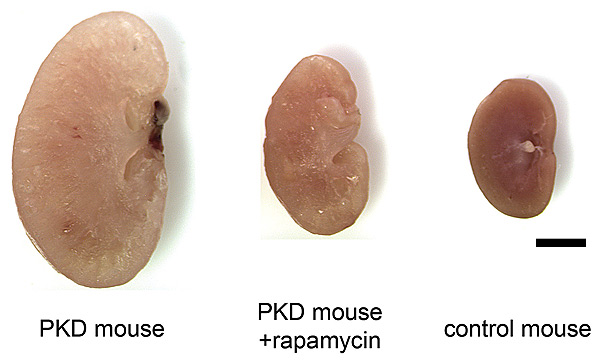
A widely available drug may be effective in treating kidney disease, report scientists at the University of California, Santa Barbara. They describe the discovery in the online edition of the Proceedings of the National Academies of Science published the week of March 20.
The drug is rapamycin, also called sirolimus, and is currently used as an immunosuppressant, to help prevent
rejection of a new, transplanted kidney.
Over 600,000 people in the U.S., and 12 million worldwide, are affected by the inherited kidney disease known as ADPKD, short for autosomal-dominant polycystic kidney disease. In the U.S., the number of individuals affected by ADPKD is greater than the number affected by cystic fibrosis, muscular dystrophy, hemophilia, Down's syndrome, and sickle cell anemia combined. The disease is characterized by the proliferation of cysts that eventually debilitate the kidney, causing kidney failure in half of all patients by the time they reach age 50.
Currently no treatment exists to prevent or slow cyst formation, and most ADPKD patients require kidney transplants or life-long dialysis for survival, explained Thomas Weimbs, director of the laboratory where the discovery was made. Weimbs is assistant professor in the Department of Molecular, Cellular and Developmental Biology at UCSB.
The scientists studied the effects of rapamycin on mice. "When we administered rapamycin to mice with polycystic kidney disease and looked at their kidneys afterwards, we were absolutely amazed," said Weimbs. "The kidneys were smaller, had smaller cysts and had retained their function."
"We have known the genetic mutations that cause ADPKD for over a decade,"
explained Weimbs. "The genetic mutations are located in the gene for the polycystin-1 protein. Unfortunately, the function of polycystin-1 has remained poorly understood, which has made it difficult to devise a treatment strategy for this disease."
Weimbs and his research team found that polycystin-1 controls an important regulatory protein called mTOR. A defect in polycystin-1 leads to over-activation of mTOR. This, in turn, causes excess growth and proliferation of kidney cells, which results in the formation of thousands of cysts that eventually destroy the kidney.
Fortunately, a highly effective inhibitor of mTOR is well known. This drug, rapamycin, was originally discovered in the 1970s in soil from Easter Island.
Weimbs and his colleagues wondered about treating kidney patients with rapamycin. Most kidney transplant patients keep their diseased kidneys in place and the transplanted kidney is an additional, third kidney. So, his colleagues David A. Goldfarb and Andrew Novick, at the Cleveland Clinic in Ohio, suggested studying transplant patients who had received rapamycin to help their bodies accept the new kidney.
The research team identified a group of four rapamycin-treated patients and found that their polycystic kidneys shrank in size by 25% over two years. The polycystic kidneys in a control group showed no change.
"Even though we only had a very small number of patients, this result is highly encouraging because it points in the right direction," said Weimbs.
It shows, for the first time, a connection between polycystin-1 and mTOR, and strongly suggests that rapamycin may be a promising drug for treating ADPKD, explained Weimbs. "The fact that rapamycin is already clinically approved for other uses will facilitate future clinical trials of the drug."
Co-authors on the paper with Weimbs are: Jonathan M. Shillingford and Seng Hui Low in the Department of Molecular and Cellular Biology at UCSB; Claire H. Larson at the Department of Cell Biology, Lerner Research Institute, Cleveland Clinic, Cleveland Ohio; Ryan Hedgepeth, Andrew C. Novick, and David A. Goldfarb at the Glickman Urological Institute, Cleveland Clinic, Cleveland, Ohio; Noel S. Murcia and Nicole Brown at the Department of Pediatrics, Case Western Reserve University, Cleveland, Ohio; Chris A. Flask at the Department of Radiology and Biomedical Engineering, Case Western Reserve University, Cleveland, Ohio; Albrecht Kramer-Zucker and Gerd Walz at the Department of Medicine, Nephrology, University Hospital Freiburg, Freiburg, Germany; Klaus B. Piontek and Gregory G. Germino at the Department of Medicine, The Johns Hopkins University School of Medicine, Baltimore, Md.



